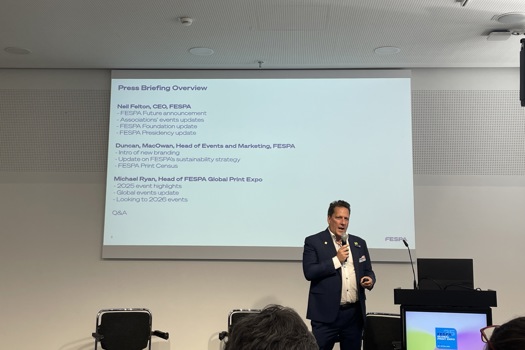Competition in the wide-format flatbed digital market heated up when Fujifilm unveiled its Acuity range of UV inkjet printers. The Acuity was pitched as an entry-level machine to complement Inca’s high-end UV flatbeds, which Fujifilm Sericol distributes,.
Like the Inca flatbed machines, the range was aimed at the screen print market, but we wanted it to be at a lower price point, with a smaller bed size, says Mark Stephenson, sales manager for digital solutions at Fujifilm UK.
First in the range was the 2504, launched in 2007, followed by the Advance a year later and then the Acuity X2, which was introduced this year. While the 2504 had just four colours, printing CMYK, the Advance added a white. There was also a speed increase from 17m2 per hour on the 2504 to 22m2 per hour on the Advance. Both the 2504 and the Advance had the same bed size, but the X2 was almost double the size of previous machines with a print bed of 98x120in.
Low-cost option
We were aiming the range at the higher resolution market, adds Stephenson. At the time, there were several machines coming out aimed at the sign market, which were low-cost, but also [in our opinion] very low-quality machines.
The Acuity can lay down droplet sizes from 6-30 picolitres. It also prints bi-directionally, so the heads return across the moving gantry and lay down droplets in the reverse direction. According to Fuji, this high quality means that the product appeals to photographers, although it also means that there is a reduction in production speed.
If you slow the press down, you get really tiny drops – therefore a higher quality print, adds Stephenson. It’s a true flatbed, keeping the media still and only moving the head. As a result, it can handle heavyweight substrates of up to 48mm thick.
Since the range was launched, there have been 22 Acuity machines sold in the UK and around 150 in Europe. It sold reasonably well when it was launched, says Stephenson. People said it was the right machine at the right time. We found early adopters were switching from their low-cost, low-quality signage printers and upgrading to the Acuity.
What we’ve started to see are specialist printers adopting the machine – companies that print onto substrates like Welsh slate, as it can handle up to 2in thick.
When buying a secondhand machine, it’s worth looking out for those fitted with the optional roll-to-roll capability
for printing onto vinyl. They are worth much more, says Stephenson.
Nothing from the X2 can be retrofitted onto the 2504 or Advance models. The manufacturer sells used machines and will part-exchange older models, depending on where the machine was from and how well it has been looked after.
A new Advance costs £110,000, including training, as well as warranty plus delivery. An X2 model costs £138,000. Secondhand prices are between £40,000-£60,000, depending on whether it has roll-to-roll capabilities, the condition of the press and the history.
When buying a used model carry out a printhead test and check the consoles – this will show how many hours it’s
been used.
Also check the UV lamps – they last 500 hours. See whether it’s time to replace them even though they are not a big expense, says Stephenson. The machine’s serial number will also reveal the service history.
Specifications
Speed
Production mode:
HD 2504 53m2 per hour
Advance 71m2 per hour
Fine art mode:
HD 2504 30m2 per hour
Advance 41m2 per hour
Print format
2504/Advance
Rigid: 48x96in full-bleed
Roll: 36x86.6in wide
X2
Rigid 98.4x120in bleed
Footprint 4.1x2m (Advance and 2504)
Max substrate thickness
48mm
Price
Advance: £110,000
Advance X2: £138,000
Used models: £40k-£60k
What to look for
* Service history
* UV lamps
* Running time










